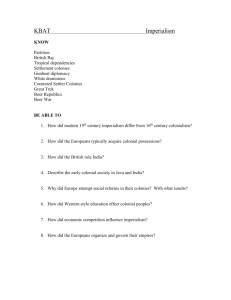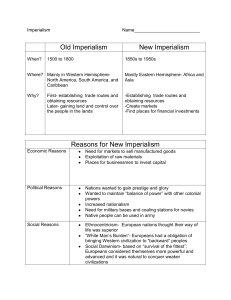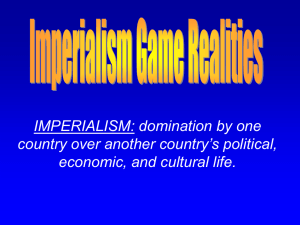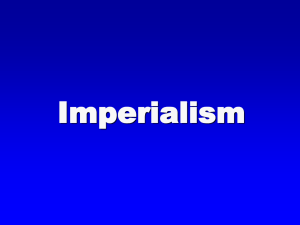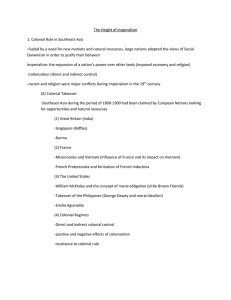the goals of cultural imperialism
advertisement
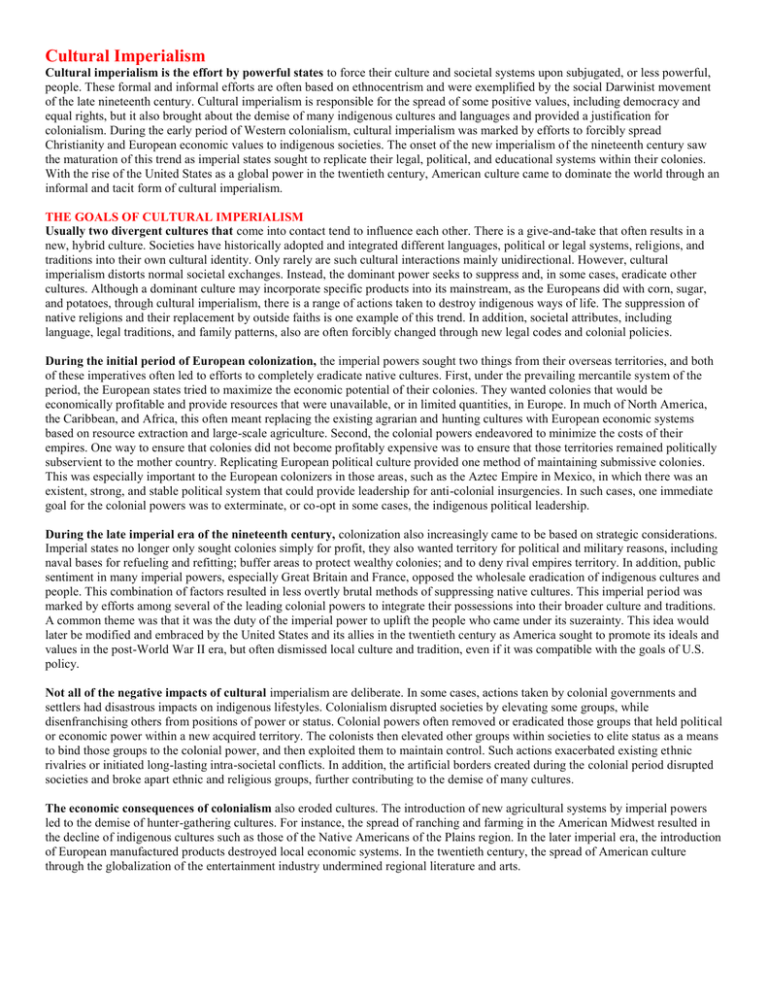
Cultural Imperialism Cultural imperialism is the effort by powerful states to force their culture and societal systems upon subjugated, or less powerful, people. These formal and informal efforts are often based on ethnocentrism and were exemplified by the social Darwinist movement of the late nineteenth century. Cultural imperialism is responsible for the spread of some positive values, including democracy and equal rights, but it also brought about the demise of many indigenous cultures and languages and provided a justification for colonialism. During the early period of Western colonialism, cultural imperialism was marked by efforts to forcibly spread Christianity and European economic values to indigenous societies. The onset of the new imperialism of the nineteenth century saw the maturation of this trend as imperial states sought to replicate their legal, political, and educational systems within their colonies. With the rise of the United States as a global power in the twentieth century, American culture came to dominate the world through an informal and tacit form of cultural imperialism. THE GOALS OF CULTURAL IMPERIALISM Usually two divergent cultures that come into contact tend to influence each other. There is a give-and-take that often results in a new, hybrid culture. Societies have historically adopted and integrated different languages, political or legal systems, religions, and traditions into their own cultural identity. Only rarely are such cultural interactions mainly unidirectional. However, cultural imperialism distorts normal societal exchanges. Instead, the dominant power seeks to suppress and, in some cases, eradicate other cultures. Although a dominant culture may incorporate specific products into its mainstream, as the Europeans did with corn, sugar, and potatoes, through cultural imperialism, there is a range of actions taken to destroy indigenous ways of life. The suppression of native religions and their replacement by outside faiths is one example of this trend. In addition, societal attributes, including language, legal traditions, and family patterns, also are often forcibly changed through new legal codes and colonial policies. During the initial period of European colonization, the imperial powers sought two things from their overseas territories, and both of these imperatives often led to efforts to completely eradicate native cultures. First, under the prevailing mercantile system of the period, the European states tried to maximize the economic potential of their colonies. They wanted colonies that would be economically profitable and provide resources that were unavailable, or in limited quantities, in Europe. In much of North America, the Caribbean, and Africa, this often meant replacing the existing agrarian and hunting cultures with European economic systems based on resource extraction and large-scale agriculture. Second, the colonial powers endeavored to minimize the costs of their empires. One way to ensure that colonies did not become profitably expensive was to ensure that those territories remained politically subservient to the mother country. Replicating European political culture provided one method of maintaining submissive colonies. This was especially important to the European colonizers in those areas, such as the Aztec Empire in Mexico, in which there was an existent, strong, and stable political system that could provide leadership for anti-colonial insurgencies. In such cases, one immediate goal for the colonial powers was to exterminate, or co-opt in some cases, the indigenous political leadership. During the late imperial era of the nineteenth century, colonization also increasingly came to be based on strategic considerations. Imperial states no longer only sought colonies simply for profit, they also wanted territory for political and military reasons, including naval bases for refueling and refitting; buffer areas to protect wealthy colonies; and to deny rival empires territory. In addition, public sentiment in many imperial powers, especially Great Britain and France, opposed the wholesale eradication of indigenous cultures and people. This combination of factors resulted in less overtly brutal methods of suppressing native cultures. This imperial period was marked by efforts among several of the leading colonial powers to integrate their possessions into their broader culture and traditions. A common theme was that it was the duty of the imperial power to uplift the people who came under its suzerainty. This idea would later be modified and embraced by the United States and its allies in the twentieth century as America sought to promote its ideals and values in the post-World War II era, but often dismissed local culture and tradition, even if it was compatible with the goals of U.S. policy. Not all of the negative impacts of cultural imperialism are deliberate. In some cases, actions taken by colonial governments and settlers had disastrous impacts on indigenous lifestyles. Colonialism disrupted societies by elevating some groups, while disenfranchising others from positions of power or status. Colonial powers often removed or eradicated those groups that held political or economic power within a new acquired territory. The colonists then elevated other groups within societies to elite status as a means to bind those groups to the colonial power, and then exploited them to maintain control. Such actions exacerbated existing ethnic rivalries or initiated long-lasting intra-societal conflicts. In addition, the artificial borders created during the colonial period disrupted societies and broke apart ethnic and religious groups, further contributing to the demise of many cultures. The economic consequences of colonialism also eroded cultures. The introduction of new agricultural systems by imperial powers led to the demise of hunter-gathering cultures. For instance, the spread of ranching and farming in the American Midwest resulted in the decline of indigenous cultures such as those of the Native Americans of the Plains region. In the later imperial era, the introduction of European manufactured products destroyed local economic systems. In the twentieth century, the spread of American culture through the globalization of the entertainment industry undermined regional literature and arts. EARLY CULTURAL IMPERIALISM AND WESTERN COLONIALISM Cultural imperialism did not begin with the period of modern European colonization. Ancient empires such as the Greeks and the Romans spread their ideals, values, and language to conquered areas. During the Middle Ages, successive English monarchs attempted to subjugate the Welsh and Scottish cultures, whereas the 1453 fall of Constantinople to the Ottoman Turks resulted in the demise of the Byzantine culture and society, and the policies of imperial Russia resulted in the suppression of non-Russian cultures on the periphery of the empire. What initially differentiated colonization after 1400 from earlier periods was the effort to justify the acquisition of new territory. Europeans initially asserted that the new areas were unoccupied and claimed possession based on the principle of first discovery. However, as it became clear that the areas had resident populations, European states struggled to develop a legal justification for conquest. Most governments asserted that they had the right to exercise dominion over native people to spread the gospel, uplift them, and improve their barbaric way of life. In an argument advanced initially by Spanish Dominicans, and adopted thereafter by most of the colonial powers, indigenous people were declared barbarians based on a range of criteria that included religion, family and marriage customs, language (especially the lack of a written language), legal systems, and political arrangements. The colonists also would contend that native cultures did not encourage people to make maximum use of land and other resources. The colonial powers argued that they should have dominion over these new areas to make them more productive. These arguments would be utilized by colonial powers in such diverse settings as the Spanish in America and the British in Ireland. Hence, the theoretical underpinnings of colonialism came to be based on the assumption that the cultures of native people were inferior to those of the Europeans and that the colonial states had a duty to transmit their customs and norms to these populations. The first Portuguese colonies in Africa were established to extract resources and establish trading posts. As a result there was only minor cultural penetration, mainly in the form of economic interaction. Even as the Spanish and Portuguese conquered the Canary Islands and Sao Tome, there was little effort made to integrate the inhabitants into the European culture. Native people did increasingly learn European languages to facilitate commerce and the slave trade. As long as the trading posts remained on the periphery of Africa and other areas, European culture initially made little impact on indigenous societies. This changed as the Spanish established colonies in the Americas. To gain ascendancy over the area, the Spanish had to destroy two major indigenous empires (the Aztec and Inca) and replace their cultural influence. This marked the first major step in the spread of cultural imperialism in the Western Hemisphere. The destruction of major native political bodies also would occur in North America with the destruction or subjugation of groups such as the Powhattan Confederacy. A second major step toward the goal of eradicating native cultures and imposing European norms and values outside of Europe came as efforts to evangelize and spread Christianity became increasingly intertwined with colonialism itself. Following Pope Alexander Vl’s (14311503) 1493 papal bull, which divided the new world between Spain and Portugal, and the subsequent Treaty of Tordesillas (1494), which reaffirmed the bull, both states pursued colonies to accumulate wealth, but did so under the justification of the need to spread Christianity. The Protestant Reformation would further accelerate these efforts, as Catholic and Protestant missionaries competed to replace native religions with their denominations of Christianity. For instance, even though the Dutch empire was based almost exclusively on trade, missionaries were dispatched to Dutch colonies to ensure that native peoples were converted to Protestantism as opposed to Catholicism. Those areas with long-recognized cultures, or with the military might to prevent European incursions, received very different treatment from the colonial states. For instance, in India, the various colonial powers often sought to gain trade and other concessions through treaty instead of conquest. One result was the survival of many cultural traditions on the Indian subcontinent. It would only be in the later imperial period that the British began to seriously erode Indian culture. In contrast, when efforts to spread Christianity, or otherwise suppress native cultures, met with failure, the colonial states often resorted to strategies of displacing native people, or exterminating whole groups of them. For instance, after the 1622 native rebellion in Virginia, the colonists engaged in widespread reprisals and a broad effort to force the native tribes from their land. Indian Tennis Party. A group of Indian men meet to enjoy tennis, a game imported by the British, at Kapurthala during the British colonial period. THE NEW AGE OF IMPERIALISM While the initial period of European colonialism after 1400 was characterized by efforts to completely eradicate or suppress native cultures, the new imperial era of the late nineteenth century was usually marked by less brutal efforts to spread dominant, colonial cultures. This period marked the height of European imperialism and the maturation of colonial systems. This era also marked the formalization of the self-perceived civilizing mission by colonial powers in areas of Africa and Asia and the prevalence of institutionalized racism. The development of new technologies during the nineteenth century not only accelerated the drive for imperialism, it also further undermined indigenous cultures. The imperial powers actively embraced new technologies, including military weapons, the telegraph, steamboats, and the railroad. These technological advances reinforced the attractiveness of European culture among native people. This included perceptions of superiority among both the colonizers and the people colonized. Many native rulers who were not under the dominance of imperial powers often hired European military and economic advisers to tacitly, or overtly, spread colonial cultures. In addition, many native leaders sent their children to European schools, a custom that the British in India, and the French in North Africa, particularly encouraged. The imperial powers also developed a series of colonial schools, including universities in some cases, to educate the native population and the colonial elites. At colonial schools, native students were taught the history, culture, and traditions of the imperial state, while their own culture was denigrated. As new colonies were added to empires for strategic reasons, there was increasing pressure on colonial governments to lessen the costs of empire. One method to accomplish this goal was to integrate local groups into the colonial hierarchy. In British colonies, such as Canada, Australia, and the Caribbean islands, this was accomplished through colonial settlers who brought with them the main elements of British culture. In other areas, the British and other colonial powers endeavored to use local populations as soldiers, government officials, and bureaucrats to lessen the costs of empire. One result of these methods was the consolidation of areas populated by small, decentralized groups or tribes under colonial powers. In binding groups to the colonial establishment, there was a range of efforts undertaken to supplant indigenous cultures with colonial or European ones. These efforts included ongoing drives to spread Christianity, European-style education and training, and inter-colonial policies that pitted favored groups against others. One result of these efforts was the emergence of native-colonial elites who adopted the main aspects of the imperial cultures, including the hierarchical class system of the dominant imperial powers. These elites increasingly formed the core of the colonial civil service and military. Even as new economic imperatives for imperialism emerged, including the discovery of diamonds in South Africa in 1867 or the rise of the ivory trade in the Belgian Congo, colonial tactics remained constant. In pursuing their economic interests, colonial powers often specifically targeted cultures to undermine existing political entities. For instance, the British promoted the use of opium to undermine Chinese culture and gain economic concessions in the 1840s. The contemporary popular notion of social Darwinism, which argued that different ethnic groups were at different stages of intellectual and physical development, was often used as a justification for imperialism. Pro-imperial politicians and officials would even use social Darwinism to contend that the imperial states had a duty to civilize the less-developed regions of the world by spreading European culture. Such sentiments were presented in contemporary newspapers and literature that reinforced public support for imperialism. Social Darwinism was also used to justify the elevation of some groups and the suppression of others. For example, many British and French colonial officials believed that people from the India subcontinent or Asia were superior to Africans and, therefore, transported people from these regions to Africa where they often became part of the colonial elite. POSTCOLONIALISM AND CULTURAL IMPERIALISM During the independence movements, the colonial powers sought to bind their possessions through economic, political, military, and cultural ties. Great Britain formed the Commonwealth of Nations and France formed the Francophone Association to perpetuate their influence in the former colonies. However, many colonial powers found that the Western-educated elites formed the core of independence movements. In colonies such as India, Burma, or Indonesia, these native elites endeavored to combine positive aspects of Western culture with their own indigenous traditions. This helped revive native culture in many areas, even as Western-style governments and economic systems remained prevalent. European culture continued to exert an enormous influence in terms of language, educational systems, and religion; nonetheless, it would be the United States, not the former colonial powers, that would ultimately have the greatest cultural impact in the post-World War II era. The economic preponderance of the United States at the end of World War II (1939-1945) allowed the nation to export a range of products and to gain access to emerging markets as states became independent. Products such as Coca-Cola, Levi’s jeans, and General Motors vehicles came to be regarded as synonymous with the United States. This American economic expansion would evolve into cultural imperialism as the world embraced U.S. products. In addition, the rise of the American entertainment industry helped expand the cultural influence of the United States. During the Cold War, the rivalry between the United States and the Soviet Union limited the global reach of American culture. With the end of the Cold War, these constraints were lifted. The result was a dramatic period of American cultural dominance. The opening of a McDonald’s restaurant in Moscow in 1990 was followed by a round of global expansion that resulted in 24,500 restaurants in 115 nations. In addition, American films, media, and music came to dominant the global entertainment industry. The Cable News Network (CNN) is broadcast in 120 countries while the world’s top-selling author is America’s Stephen King. In 1992 Disney even opened a theme park near Paris. American cultural expansion has been aided by the revolution in telecommunications and the widespread use of English. For instance, approximately 90 percent of the content on the Internet is in English. As American products continue to find new markets and cultural icons such as Spiderman or Superman replace local heroes, many local customs will give way to a global cultural uniformity dominated by the United States. The prominence of U.S. culture has even led foreign companies to utilize American symbols in advertising. A range of foreign corporations use cowboys or American icons to advertise a variety of products such as cigarettes, alcohol, and clothing. Critics of these trends have decried what they perceive to be a second century of American cultural homogeneity. While many aspects of American culture have positive connotations, including the ideals of gender and racial equality, and political and economic freedom, the violence and materialism that many perceive is inherent in the United States has produced a backlash. States such as France have imposed limitations on American media products, including films and music (the French government briefly tried to prevent the American film Jurassic Park from being released in France). On a broader level, opponents of globalization have increasingly targeted American firms such as Starbucks as symbols of what is wrong with the contemporary world market. Finally, radical anti-Western extremist groups have defined themselves by their opposition to the main features of American culture.
